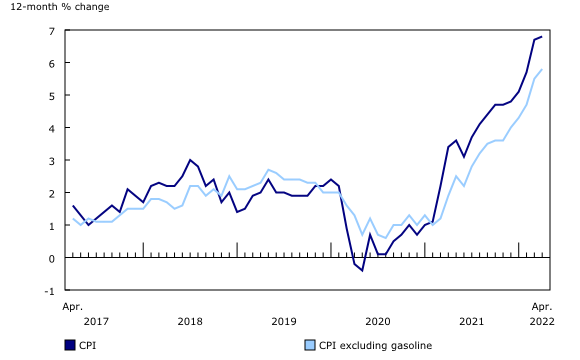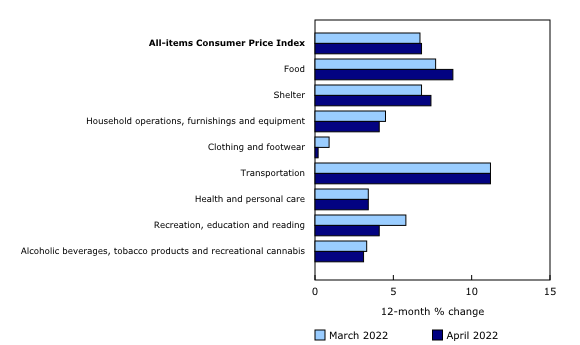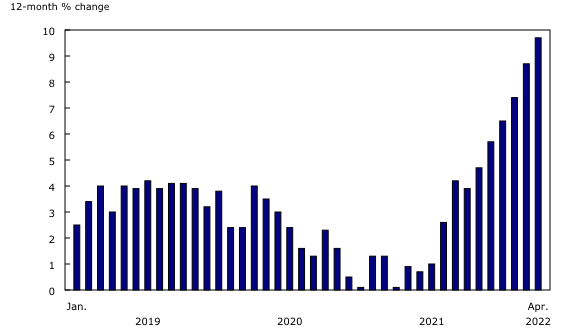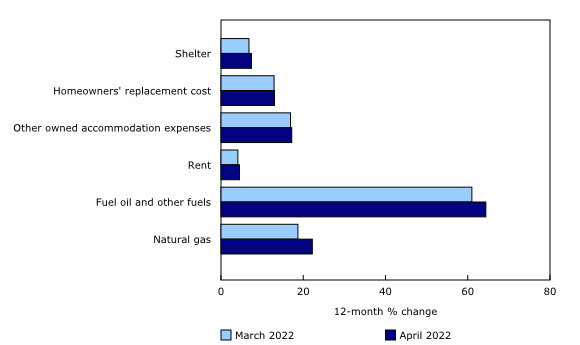Consumer Price Index, April 2022
Archived Content
Information identified as archived is provided for reference, research or recordkeeping purposes. It is not subject to the Government of Canada Web Standards and has not been altered or updated since it was archived. Please "contact us" to request a format other than those available.
Released: 2022-05-18
April 2022
6.8% 
(12-month change)
In April, Canadian consumer prices rose 6.8% year over year, a slight increase from March (+6.7%).
The year-over-year increase in April was largely driven by food and shelter prices. Gas prices increased at a slower pace in April compared with March, moderating the acceleration of the all-items Consumer Price Index (CPI) in April.
Excluding gasoline, the CPI rose 5.8% year over year in April, after a 5.5% gain in March. This was the fastest pace since the introduction of the all-items excluding gasoline special aggregate in 1999.
Russia's invasion of Ukraine in late February continued to affect energy, commodity and, most notably, food prices. With the unemployment rate falling to a record low in April, strong employment figures tend to put upward pressure on prices. In April, average hourly wages for employees rose 3.3% on a year-over-year basis, meaning that, on average, prices rose faster than wages, and Canadians experienced a decline in purchasing power.
On a monthly basis, the CPI rose 0.6% in April after a 1.4% gain in March. On a seasonally adjusted monthly basis, the CPI rose 0.7%.
Important enhancements to the CPI
As part of Statistics Canada's rigorous and ongoing efforts to maintain the quality and relevance of the CPI, important enhancements are planned for June 2022:
• The introduction of used vehicle prices;
• CPI basket update.
For information on these enhancements, please see the Note to readers.
Prices for groceries continue to increase
Canadians paid 9.7% more in April for food purchased from stores compared with April 2021. This increase, which exceeded 5% for the fifth month in a row, was the largest increase since September 1981. For comparison, from 2010 to 2020, there were five months when prices for food purchased from stores increased at a rate of 5% or higher.
On a year-over-year basis, increases in food prices have been broad-based, with consumers paying more for nearly everything at the grocery store. Basics, such as fresh fruit (+10.0%), fresh vegetables (+8.2%) and meat (+10.1%), were all more expensive in April compared with a year earlier. Prices for starchy foods such as bread (+12.2%), pasta (+19.6%), rice (+7.4%) and cereal products (+13.9%) also increased. Additionally, a cup of coffee (+13.7%) cost more in April 2022 than in April 2021.
The recent period of higher food prices has occurred within the context of numerous events that are continuing to fuel higher prices. With both countries being major wheat exporters, Russia's invasion of Ukraine in late February put upward price pressure on food products that use wheat. Poor weather in growing regions has also impacted prices for food. Additionally, higher prices for inputs such as fertilizer and natural gas continued to increase the cost of production for farmers, who have passed some of these costs on to consumers.
Higher fuel oil prices contribute to higher shelter costs
In April, shelter costs rose 7.4% year over year, the fastest pace since June 1983, following a 6.8% increase in March. Higher prices for energy sources used to heat homes, such as natural gas (+22.2%) and fuel oil and other fuels (+64.4%), contributed to the increase.
Reflecting the dynamic Canadian housing market, homeowners' replacement cost (+13.0%) which is related to the price of new homes, and other owned accommodation expenses (+17.2%) which includes commissions on the sale of real estate, both increased in April.
The mortgage interest cost Index (+0.2%) increased on a month-over-month basis for the first time since April 2020.
Monthly gasoline prices slow in April after strong increase in March
In April, gasoline prices fell slightly on a month-over-month basis (-0.7%), following a gain of 11.8% in March. Global crude oil prices declined in April, in part due to lower global demand expectations.
Year over year, consumers paid 36.3% more for gasoline in April compared with 39.8% in March.
Explore the Consumer Price Index tools that can help you make informed financial decisions
Check out the Personal Inflation Calculator! This interactive calculator allows you to enter dollar amounts in the common expense categories to produce a personalized inflation rate, which you can compare to the official measure of inflation for the average Canadian household—the Consumer Price Index (CPI).
Visit the Consumer Price Index portal to find all CPI data, publications, interactive tools, and announcements highlighting new products and upcoming changes to the CPI in one convenient location.
Consult the Consumer Price Index Data Visualization Tool to access current and historical CPI data in a customizable visual format.
Listen to the latest Eh Sayers podcast, to learn more about supply chains.
Regional highlights
On a year-over-year basis, the CPI increased at a faster pace in April than in March in seven provinces.
Although prices in Ontario increased 6.9% in April year over year, they grew at a slower pace than in March (+7.0%). This is in part attributed to the gradual implementation of the provincial and federal agreement to subsidize licensed daycare and the provincial government's removal of passenger vehicle registration fees.
Price growth slowed the most in Alberta, partly due to the temporary removal of the fuel tax on gasoline initiated by the provincial government.
Rent prices rise in the most populous provinces
Rent prices increased in April (+4.5%) compared with the same month in 2021. The increase in rent was partly driven by price increases in Canada's most populous provinces: Ontario (+5.3%), Quebec (+4.3%) and British Columbia (+6.4%).
Note to readers
Used vehicle prices
Statistics Canada has published a technical paper, "Measuring price change for used vehicles in the Canadian Consumer Price Index." The paper outlines the proposed plan for introducing used vehicle prices in the Consumer Price Index (CPI), including data and methods.
With the introduction of the 2021 CPI basket, Statistics Canada will use administrative data to strengthen the measurement of price change for used vehicles, which will replace the current method of measuring price change by proxy. The enhancements will be incorporated into the calculation of the purchase of passenger vehicles index. With the introduction of used vehicle prices in the CPI, two new series will be published: purchase of new passenger vehicles (2022-04=100) and purchase of used passenger vehicles (2022-04=100). Both price index series will be available starting April 2022 and will be published at the national level.
Used vehicle prices are scheduled to be introduced with the May 2022 monthly price change (release in June 2022), with no level adjustment for historical changes in the all-items CPI. This approach is consistent with the way other products have been introduced in the CPI such as cellular services, electronic devices and cannabis. This approach follows international best practices as well as recommendations by Statistics Canada's Price Measurement Advisory Committee.
For additional information or to provide comments on the proposed enhancement, users may contact the Consumer Prices Division at statcan.cpddisseminationunit-dpcunitedediffusion.statcan@statcan.gc.ca.
Consumer Price Index basket update in June 2022
The CPI is based on a fixed basket of goods and services designed according to international standards and methods. On June 15, 2022, updated basket weights for the goods and services used in the calculation of the CPI will be made available in table 18-10-0007-01. The new basket weight reference period will be 2021, based on the most recent national household final consumption expenditure data. Alternative data for 2021 will be used to account for pandemic-related shifts at more detailed levels of geography and within the various CPI components.
One week later, on June 22, the May 2022 CPI will be released, based on the updated basket weights.
For general information on basket updates, consult The Canadian Consumer Price Index Reference Paper, chapter 8, "Weights and basket updates."
For the latest analysis of evolving consumer expenditure patterns during the pandemic recovery, see the adjusted price index, which has provided a complementary measure of consumer price inflation based on a more timely set of national weights from alternative sources of expenditure data, such as those from the Bank of Canada.
Going forward, and to ensure an even greater degree of relevance, Statistics Canada will move towards annual basket updates based on the most recent household expenditure data.
Real-time data tables
Real-time data table 18-10-0259-01 will be updated on May 30. For more information, consult the document "Real-time data tables."
Planned maintenance
The Consumer Price Index Data Visualization Tool will be temporarily unavailable from June 15 to 22, 2022, due to planned maintenance related to the updated basket.
Next release
The updated basket weights for the Consumer Price Index, based on the 2021 weight reference period, will be released on June 15.
The Consumer Price Index for May will be released on June 22.
Products
The "Consumer Price Index Data Visualization Tool" is available on the Statistics Canada website.
More information on the concepts and use of the Consumer Price Index (CPI) is available in The Canadian Consumer Price Index Reference Paper (62-553-X).
For information on the history of the CPI in Canada, consult the publication Exploring the First Century of Canada's Consumer Price Index (62-604-X).
Two videos, "An Overview of Canada's Consumer Price Index (CPI)" and "The Consumer Price Index and Your Experience of Price Change," are available on Statistics Canada's YouTube channel.
Contact information
For more information, or to enquire about the concepts, methods or data quality of this release, contact us (toll-free 1-800-263-1136; 514-283-8300; infostats@statcan.gc.ca) or Media Relations (statcan.mediahotline-ligneinfomedias.statcan@statcan.gc.ca).
- Date modified:







